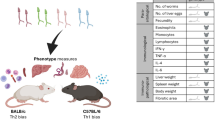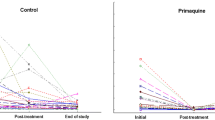Abstract
Parasite-mediated selection is currently believed to play an important role in life-history evolution. To assess how simple hematoserological and biochemical condition indices reflect host immunocompetence and infection resistance controlled laboratory experiments are required. We addressed these issues by infecting laboratory rats with the standard dose of embryonated eggs of a neurotropic nematode Toxocara canis. Urine baseline corticosterone concentrations, measured 1 week before infection, predicted the number of nematode larvae later recovered from host brains. Thus, this noninvasive clinical marker appeared useful for assessment of potential infection resistance. Rats who had accumulated high number of larvae in their brains and muscle had large spleens and high peripheral eosinophil counts 17 days postinfection. This finding is consistent with the concept that induction of eosinophilic Th2 type humoral immune response benefits the parasite rather than host. Hence, excessive peripheral eosinophilia and spleen enlargement are not markers of efficient antiparasite response in larval toxocariasis.


Similar content being viewed by others
References
Acquarone C, Cucco M, Malacarne G (2002) Annual variation of immune condition in the hooded crow (Corvus corone cornix). J Ornithol 143:351–355
Adamo SA (2004) How should behavioural ecologists interpret measurements of immunity? Anim Behav 68:1443–1449
Allen JE, Maizels RM (1997) Th1–Th2: reliable paradigm or dangerous dogma? Immunol Today 18:387–392
Anderson BH, Watson DL, Colditz IG (1999) The effect of dexamethasone on some immunological parameters in cattle. Vet Res Commun 23:399–413
Apanius V (1998) Stress and immune defense. Adv Study Behav 27:133–153
Augustsson H, Lindberg L, Hoglund AU, Dahlborn K (2002) Human-animal interactions and animal welfare in conventionally and pen-housed rats. Lab Anim 36:271–281
Bamberg E, Palme R, Meingassner JG (2001) Excretion of corticosteroid metabolites in urine and faeces of rats. Lab Anim 35:307–314
Barnard CJ, Behnke JM, Sewell J (1996) Environmental enrichment, immunocompetence, and resistance to Babesia microti in male mice. Physiol Behav 60:1223–1231
Braude S, Tang-Martinez Z, Taylor GT (1999) Stress, testosterone, and the immunoredistribution hypothesis. Behav Ecol 10:345–350
Brennan FX, Ottenweller JE, Seifu Y, Zhu G, Servatius RJ (2000) Persistent stress-induced elevations of urinary corticosterone in rats. Physiol Behav 71:441–446
Brunaska M, Dubinsky P, Reiterova K (1995) Toxocara canis: ultrastructural aspects of larval moulting in the maturing eggs. Int J Parasitol 25:683–690
Buchanan KL (2000) Stress and the evolution of condition-dependent signals. Trends Ecol Evol 15:156–160
Cox DM, Holland CV (1998) The relationship between numbers of larvae recovered from the brain of Toxocara canis-infected mice and social behaviour and anxiety in the host. Parasitology 116:579–594
Cuéllar C, Fenoy S, del Aguila C, Guillen JL (2001) Isotype specific immune responses in murine experimental toxocariasis. Mem Inst Oswaldo Cruz 96:549–553
D’Ambrosio D, Iellem A, Colantonio L, Clissi B, Pardi R, Sinigaglia F (2000) Localization of Th-cell subsets in inflammation: differential thresholds for extravasation of Th1 and Th2 cells. Immunol Today 4:183–186
Dhabhar FS, McEwen BS (1997) Acute stress enhances while chronic stress suppresses cell-mediated immunity in vivo: a potential role for leukocyte trafficking. Brain Behav Immun 11:286–306
Hanley KA, Stamps JA (2002) Does corticosterone mediate bidirectional interactions between social behaviour and blood parasites in the juvenile iguana, Ctenosauria similis? Anim Behav 63:311–322
Hoffman-Goetz L, Pedersen BK (1994) Exercise and the immune system: a model of the stress response. Immunol Today 15:382–387
Hosken DJ, O’Shea JE (2001) Sperm production and immune function in two Australian bats, Chalinolobus morio and Nyctophilus geoffroyi. Ethol Ecol Evol 13:173–180
Kapel CMO, Gamble HR (2000) Infectivity, persistence, and antibody response of domestic and sylvatic Trichinella spp. in experimentally infected pigs. Int J Parasitol 30:215–221
Kayes SG (1984) Spleen cell responses in experimental murine toxocariasis. J Parasitol 70:522–529
Kurtz J, Reinhold K, Engqvist L (2000) Immunosuppression under stress: necessary for condition-dependent signalling? Trends Ecol Evol 15:418–419
Lochmiller RL, Dabbert CB (1993) Immunocompetence, environmental stress, and the regulation of animal populations. Trends Comp Biochem Physiol 1:823–855
Lochmiller RL, Deerenberg C (2000) Trade-offs in evolutionary immunology: just what is the cost of immunity? Oikos 88:87–98
Lynch JW, Khan MZ, Altmann J, Njahira MN, Rubenstein N (2003) Concentrations of four fecal steroids in wild baboons: short-term storage conditions and consequences for data interpretation. Gen Comp Endocrinol 132:264–271
MacPhee IAM, Turner DR, Oliveira DBG (2000) The role of endogenous steroid hormones in the generation of T helper 2-mediated autoimmunity in mercuric chloride-treated Brown–Norway rats. Immunology 1:141–146
Meeusen ENT, Balic A (2000) Do eosinophils have a role in the killing of helminth parasites? Parasitol Today 16:95–101
Møller AP, Erritzøe J (2000) Predation against birds with low immunocompetence. Oecologia 122:500–504
Nunn CL, Gittleman JL, Antonovics J (2000) Promiscuity and the primate immune system. Science 290:1168–1170
Ots I, Murumägi A, Hõrak P (1998) Hematological health state indices of reproducing great tits: methodology and sources of natural variation. Funct Ecol 12:700–707
Ovington KS, Behm CA (1997) The enigmatic eosinophil: investigation of the biological role of eosinophils in parasitic helminth infection. Mem Inst Oswaldo Cruz 92:93–104
Owens IPF, Wilson K (1999) Immunocompetence: a neglected life history trait or conspicuous red herring? Trends Ecol Evol 14:170–172
Pritchard DI, Hewitt C, Moqbel R (1997) The relationship between immunological responsiveness controlled by T-helper 2 lymphocytes and infections with parasitic helminths. Parasitology 115:33–44
Read AF, Allen JA (2000) The economics of immunity. Science 290:1104–1105
Retana-Márquez S, Bonilla-Jaime H, Vázquez-Palacios G, Dominguez-Salazar E, Martínez-García R, Velázquez-Moctezuma J (2003) Body weight gain and diurnal differences of corticosterone changes in response to acute and chronic stress in rats. Psychoneuroendocrinology 28:207–227
Ryder J (2003) Immunocompetence: an overstretched concept? Trends Ecol Evol 18:319–320
Sheldon BC, Verhulst S (1996) Ecological immunology: costly parasite defences and trade-offs in evolutionary ecology. Trends Ecol Evol 11:317–321
Shutler D, Alisauskas RT, McLaughlin JD (1999) Mass dynamics of the spleen and other organs in geese: measures of immune relationships to helminths? Can J Zool 77:351–359
Siegel HS (1985) Immunological responses as indicators of stress. World’s Poult Sci J 41:36–44
Smith KG, Hunt JL (2004) On the use of spleen mass as a measure of avian immune system strength. Oecologia 138:28–31
Smith FV, Barnard CJ, Behnke JM (1996) Social odours, hormone modulation and resistance to disease in male laboratory mice, Mus musculus. Anim Behav 52:141–153
van der Kleij D, Latz E, Brouwers JF, Kruize YC, Schmitz M, Kurt-Jones EA, Espevik T, de Jong EC, Kapsenberg ML, Golenbock DT, Tielens AG, Yazdanbakhsh M (2002) A novel host–parasite lipid cross-talk. Schistosomal lyso-phosphatidylserine activates toll-like receptor 2 and affects immune polarization. J Biol Chem 277:48122–48129
Wingfield JC, Sapolsky RM (2003) Reproduction and resistance to stress: when and how. J Neuroendocrinol 15:711–724
Zuk M, Stoehr AM (2002) Immune defense and host life history. Am Nat 160:9–22
Acknowledgements
We thank Kaile Peet, Maria Sõber, and Anu Tiitsaar for assistance in experiments and Indrek Ots, Sirje Ots, Anu Tamm, and Lauri Saks for their help with the clinical analyses. Sulev Kõks and Urmas Siigur kindly introduced us to the basic procedures of rat handling. The study was financially supported by the Estonian Science Foundation grants #4537 and 6222 (to PH). All animal procedures were approved by the Tartu University Animal Care Committee in accordance with the European Community Directive of 24 November 1986 (86/609/EEC).
Author information
Authors and Affiliations
Corresponding author
Rights and permissions
About this article
Cite this article
Hõrak, P., Tummeleht, L. & Talvik, H. Predictors and markers of resistance to neurotropic nematode infection in rodent host. Parasitol Res 98, 396–402 (2006). https://doi.org/10.1007/s00436-006-0142-y
Received:
Accepted:
Published:
Issue Date:
DOI: https://doi.org/10.1007/s00436-006-0142-y




